E-Museum of Pyrographic ArtAntique Art Hall
|
| - Café Flambé - | - Portraits and Paintings - | - Decorative and Applied Art - |
| - Folk and Traditional Art - | - Antique Art - | - Special Hall - | - Sculpture - |
| - Children's Hall - | - Bookstore and Library - | - Tools and Techniques - |
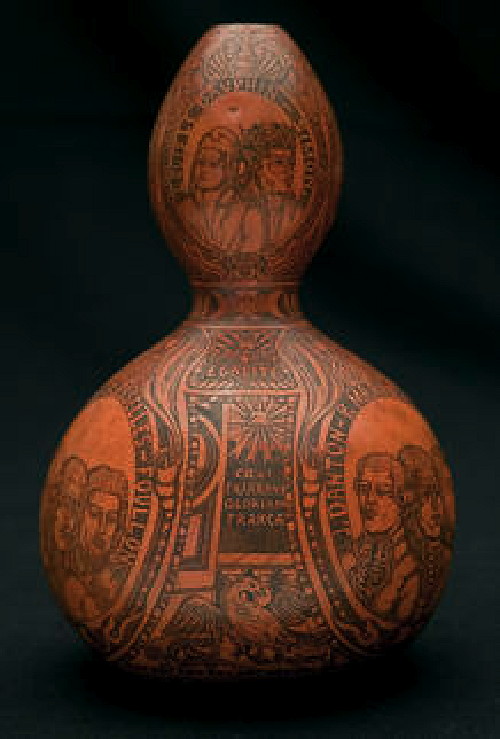 |
| VIEW 1: EGALITE (Equality)—French Revolution Gourd,
by Jean Roux, 1793 |
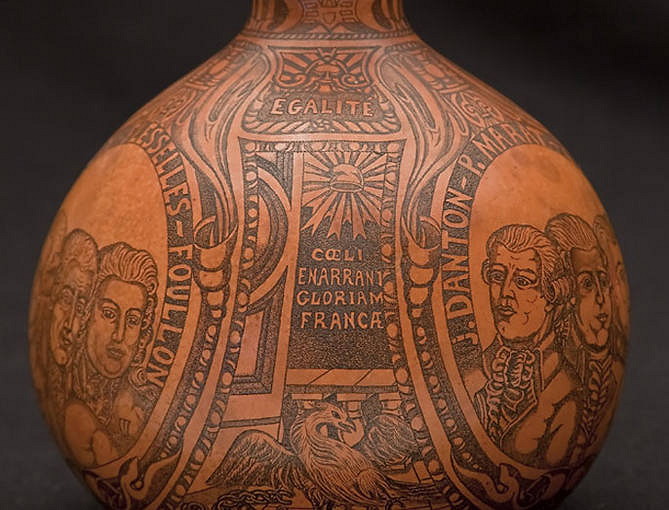 |
| VIEW 2: LATIN INSCRIPTION—French Revolution Gourd
by Jean Roux, 1793 Latin wording is the following: COELIShown above is a close-up view of the Egalité side showing the Latin inscription and a raptor below it. |
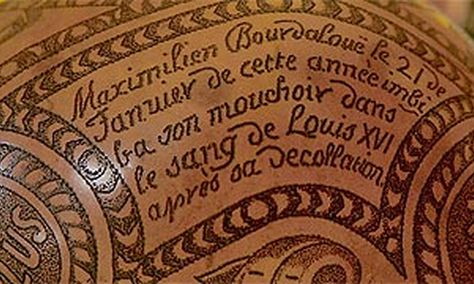 |
| VIEW 3: HISTORIC INSCRIPTION—French Revolution Gourd
by Jean Roux, 1793 Who inscribed the following history of this gourd: "Maximilien Bourdaloue the 21st of January of this year |
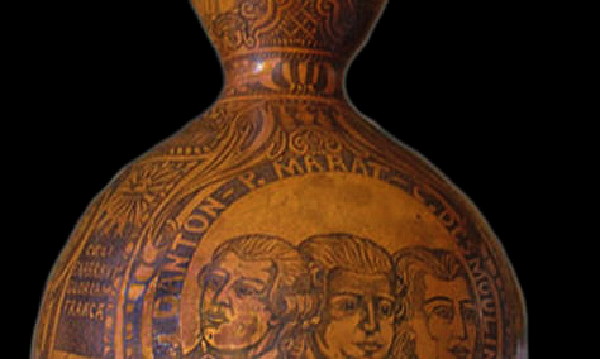 |
| VIEW 4: DECORATIVE DETAILS—French Revolution Gourd,
by Jean Roux, 1793 |
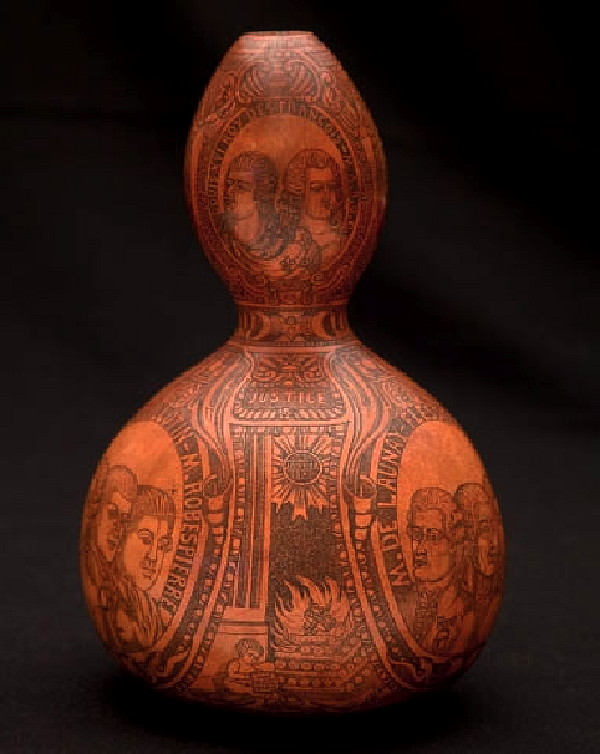 |
| VIEW 5: JUSTICE—French Revolution Gourd,
by Jean Roux, 1793 |
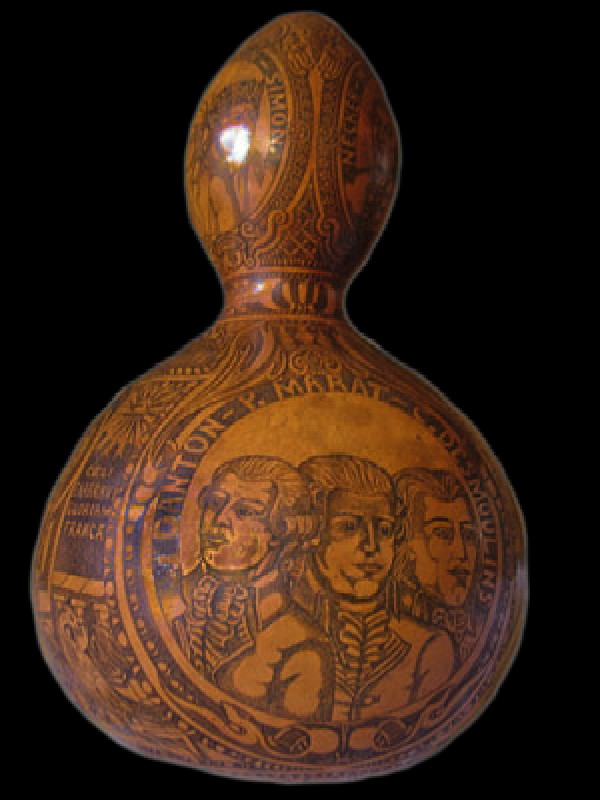 |
| VIEW 6: PORTRAIT MEDALLION 1—French Revolution Gourd,
Portrait bust trio: J. DANTON, P. MARAT, and C. DESMOULINS by Jean Roux, 1793 |
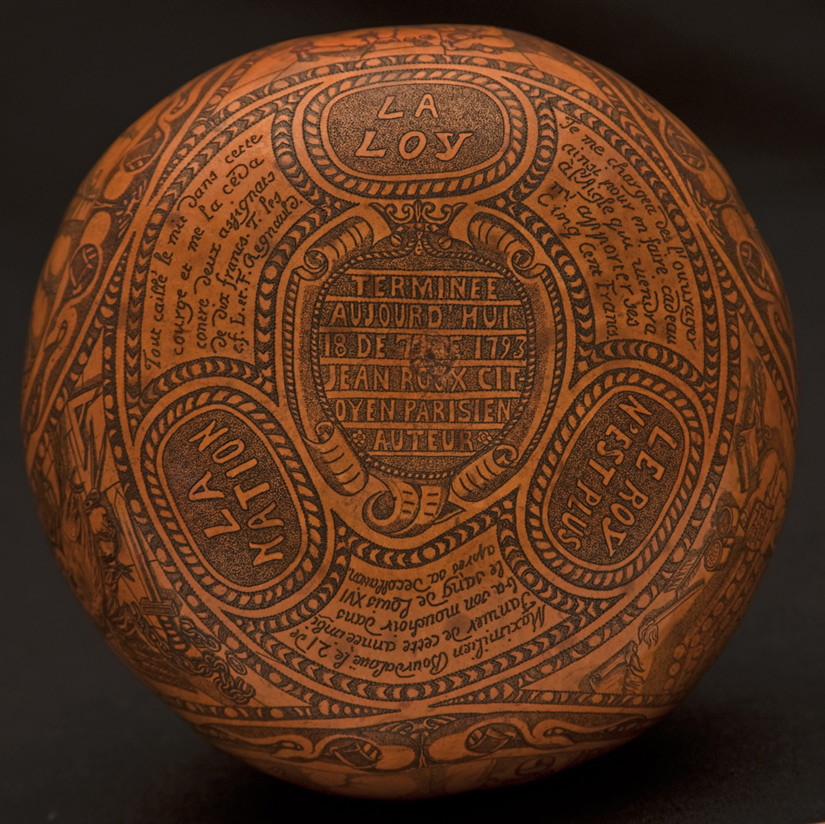 |
| VIEW 7: HISTORIC INSCRIPTIONS—French Revolution Gourd With an historic inscription claiming it contains the blood of King Louis XVI of France by Jean Roux, 1793 Whose signature is in the center |
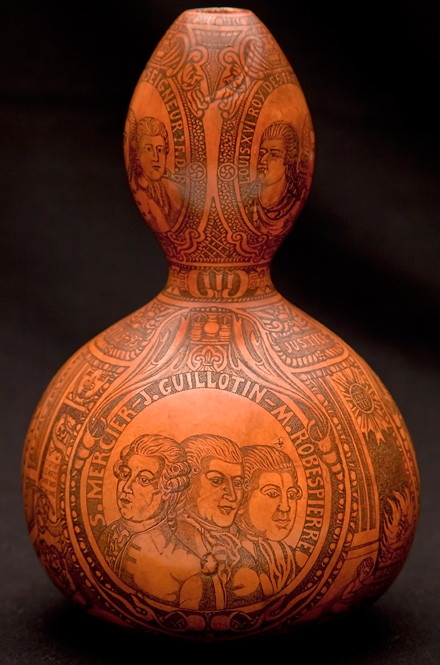 |
| VIEW 8: PORTRAIT MEDALLION 2—French Revolution Gourd,
Portrait bust trio: S. MERCIER, J. GUILLOTIN, and M. ROBESPIERRE by Jean Roux, 1793 Source: Wired Science web site. |
By Parisian artist Jean Roux is the 1793 Louis XVI French Revolution gourd exhibited in several views above. It came to light in October 2010 in a number of articles in the international press because of its macabre history—a history that is inscribed beautifully on the work of art itself as shown in the penultimate image above (View 7) as well as in View 3 above, where the principal story is translated from the French to English in the caption.
The headlines came out when an Italian family in Bologna took the beautifully decorated gourd out of their vault to have it authenticated by a group of scientists in Barcelona as containing the blood of King Louis XVI in the stains on the interior of the gourd.
Gourds of this type (bottle gourds) were used in earlier centuries in Europe to store gunpowder, as well as water or wine, for people like soldiers, travelers, pilgrims, and shepherds. Although in some of the accounts, it was said that this gourd was originally used for gunpowder, it seems safe to assume that this particular gourd was probably a new one (i.e., not yet used for gunpowder, when Maximilien Bourdaloue put his handkerchief in it to keep for posterity and asked Jean Roux to decorate it in the hope that Napoleon might want to acquire it). The Italian family that now owns it has remained anonymous, so it is difficult to know its subsequent provenance, which might prove to be another interesting story if and when we learn of it.
As might be expected, the exquisite decorative art work on the gourd has been mostly overlooked by the general press and its technique sometimes misnamed. In one English version, where the large image of the signature by the artist in the center, surrounded by the three historic inscriptions interspersed with decorative medallions bearing the words LA NATION (THE NATION), LOY (LAW), and LE ROY N'EST PLUS (THE KING IS NO MORE), it was reported the work was done with a "flame tool," conjuring an image of the artist working with a little blowtorch, which, of course, is not the case.
Further research revealed versions in Spanish (with some additional images) where in some the technique was (correctly) termed "pirografía ("pyrography") but in others where apparently one reporter, not knowing what that was, mistakenly wrote "pictografía" ("pictography"), that term was picked up and then repeated in a few other reports. In various versions, the exquisitely decorated gourd was said to be valued at 2 million Euros (one source reports 500,000 Euros); no doubt its significant decorative value was barely, or maybe not at all, a part of that appraisal.
The central inscription in the seventh view translates in English to the following:
FINISHED
TODAY
18TH OF SEPT 1793
JEAN ROUX
PARISIAN CITIZEN
AUTHOR
For those interested in the research and translation part: First, the "September" translation in Jean Roux's signature was written originally as 7BRE (mostly obliterated). This convention goes back to the name of the month, which was the seventh month (hence the 'sept' or 'seven' part) in the earlier Julian calendar. Second, the E-Museum's research dept., at least, is thinking that perhaps the word "AUTHOR" here does not refer to any of the artist's writings but instead signifies that he is the 'author' (AUTEUR in French, here meaning creator or maker) of this art work, an expression used commonly in French if not in English.
If you have either any questions to ask or any information to offer regarding this 1793 gourd of the French Revolution by Jean Roux or any other works by Jean Roux, please e-mail the E-Museum Curator.
You are leaving the Jean Roux Salon featuring
His 1793 French Revolution Gourd
You can return to the
Antique Hall
or visit one of the following:
Pyrographic Art Exhibit Halls:
Portraits and Paintings
Decorative and Applied Art
Sculpture
Traditional and Folk Art
Children's Pyrographic Art
Special Pyrographic Art
The Book Store and E-Museum Library
Pyrography Tools and Techniques
Your questions and comments are welcome and appreciated.
Please e-mail the E-Museum Curator
Back to E-Museum Entrance homepage
© 2011 Kathleen M. Garvey Menéndez, all rights reserved.
13 May 2011.

